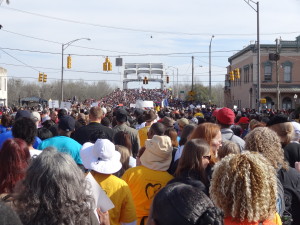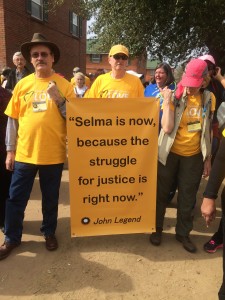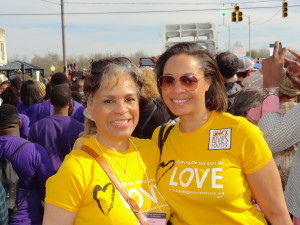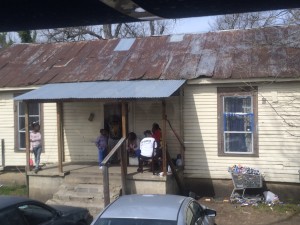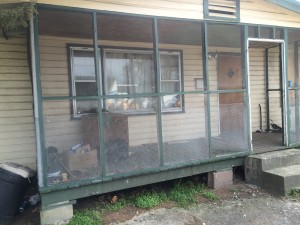Fifty years ago on this date, thousands who believe in liberty and justice for all reached a milestone: Their five-day march from Selma to the Alabama state capitol in Montgomery was over. However, their peaceful struggle for voting rights for all American citizens, granted by the U.S. Constitution, was not. In fact, since 1965, the struggle for equality and human decency has been bequeathed to each generation because of unChristlike individuals in the South—and in northern states such as Wisconsin and Ohio—who are perversely pleasured by treating others in ways that they would not want to be treated.
Unquestionably, none of them wants to be denied any of their legal rights. They certainly would not want to be maimed or murdered for trying to exercise that right, as was the case on the Edmund Pettus Bridge on March 7, 1965. Ironically, many of these people call themselves Christians, yet actively snub these words from their favorite text: “Inasmuch as ye have done it unto one of the least of these my brethren, ye have done it unto me.” Matthew 25:40
“Justice too long delayed is justice denied” ~MLK
Others are aligned with a different set of values, those of the Rev. Martin Luther King, who wrote from his cell in Birmingham, “Justice too long delayed is justice denied.” So, on the 50th anniversary of that Bloody Sunday on the Edmund Pettus Bridge, 80,000 likeminded people flocked to Selma to stand in solidarity with those who were viciously brutalized for daring to cross the bridge to demand the right to vote. My daughter and I were among them.
The experience was a bit surreal. All the hotels in the area were booked. But an Internet search for groups traveling to Selma led me to a national conference of Unitarian Universalists (UU) who were commemorating the 50th anniversary of the march. They had a block of rooms at a downtown Birmingham hotel, and offered a one-day package that included the bus trip from the hotel to Selma and back, with meals. Perfect!
Maybe we were separated at birth
Frankly, I knew very little about the UU church. But oddly enough, many years ago, I took the “Belief-O-Matic” quiz on Beliefnet.com. I’d taken it before. I was a little bit of this, a little bit of that and a whole lot New Thought Christian. I figured that the outcome would be the same. But this time, after answering 20 questions about my concept of God, the afterlife, human nature, and more, the Belief-O-Matic churned out a different response: I was 100% Unitarian Universalist. (The site says it’s for entertainment purposes, so entertain yourself and test drive your beliefs!)
A decade later, after never attending a UU church service, Fate sent me to Selma, to share this voting rights adventure with “my peeps”—sisters and brothers from another mother, who see the Divine in every body.
The synchronicity became more intriguing—and meaningful—when I discovered that the UUs had been actively involved with the voting rights movement in the mid-sixties. Living their beliefs, a number of Unitarian Universalists who were fearlessly sincere about equality, put some skin in the game. Literally. They left their homes and families in various parts of the country, and worked and lived alongside the Freedom Riders. Some were beaten or murdered for their effort.
If you saw the movie “Selma,” you’ll recall the scene where two ministers were attacked for being “nigger lovers.” One was brutally beaten to death: Rev. James Reeb, a UU minister. At the end of the movie, producers noted that one woman was murdered in an ambush on March 25, as she drove black voting rights workers to the airport, hours after the final march. Viola Liuzzo was a Detroit housewife and yes, a Unitarian Universalist.
Destination: Destiny
When I boarded my plane to Birmingham, my daughter was already onboard. Her flight from New York to had one stop in Chicago. How cool was that?
I thought nothing could top those travel arrangements—until we left the hotel in Birmingham on Sunday morning with 500 of the most genuinely kind and loving individuals I have ever had the great fortune to meet. For them, boarding buses to Selma was a re-enactment of UU history. For me, wearing their bright yellow “Standing on the Side of Love” T-shirt was an honor.
Only a handful of these souls was wearing a black “human body costume” (Drama Queen Workshop-speak). But it was rare to glance through the crowd and not see someone wearing a UU “Black Lives Matter” sticker. (See, I told you they were “my peeps”.)
A few had extra ribbons on their conference name tags that said “Veteran.” They had come to Alabama or had harbored black and white voters’ rights workers in their homes in 1965 and survived.
Walking across the Edmund Pettus Bridge that day evoked both the sadness I experienced while watching footage of the barbaric Alabama police on the evening news that Bloody Sunday in 1965. But there was also a feeling of victory and empowerment, walking the path of the subsequently victorious march across that bridge weeks later, on March 25.
Is Selma a bridge too far?
The experience was bittersweet for my daughter, Maiysha, as well: She was humbled to be part of the historic commemorative march, but dismayed by the condition of the city that brought the nation’s attention to the post-slavery brutality of the South.
“This place should be a monument to a movement!” she screamed in utter exasperation.
Actually, Selma is a monument, a monument to stagnation and to the pain and human suffering of those whom the voting rights movement left behind; the barely-getting-by life of a people with few life options. Their futures were planted and deeply rooted in the city, where it withered, rotted and died, as reflected in the homes we passed near downtown Selma.
Selma’s tiny downtown area was the same. In fact, it could have been a movie lot: edifices, but no commerce inside—with the exception of the large Diamond Center and Cadillac dealership.
One nightclub along the main strip took advantage of the worldwide attention, and cried out to the throngs passing by. Few even noticed.
Millionaire movie stars, a billionaire entertainment mogul and two U. S. presidents have seen Selma in recent weeks. Another 80,000 of us came to pay homage. We waved at the people along our path, then we boarded our buses and left Selma exactly as we found it: Forgotten and forlorn.
How does Selma cross a bridge to victory?


